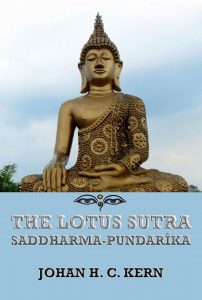The Lotus Sutra (Saddharma-Pundarika) – Johan Hendrik Caspar Kern
The Lotus Sutra is considered the greatest of all Buddhist scriptures. It interprets the person of Buddha as a manifestation of metaphysical entity and synthesizes the two aspect of his being: his incarnation in human life and his real ontological identity. It teaches salvation for all creatures, reducing the Three Vehicles to One Vehicle, on the principle of “One is all and All is One.” We know nothing of its authorship or its place of origin, but its first translation into Chinese is dated c. 255 A-D.
Format: Paperback.
The Lotus Sutra (Saddharma-Pundarika).
ISBN: 9783849690656
Available at amazon.com and other venues.
From the teachings of the Lotus Sutra (from wikipedia)
The Lotus Sūtra is known for its extensive instruction on the concept and usage of skillful means – (Sanskrit: upāya, Japanese: hōben), the seventh paramita or perfection of a Bodhisattva – mostly in the form of parables. The many ‘skillful’ or ‘expedient’ means and the “three vehicles” are revealed to all be part of the One Vehicle (Ekayāna), which is also the Bodhisattva path. This is also one of the first sutras to use the term Mahāyāna, or “Great Vehicle”. In the Lotus Sūtra, the One Vehicle encompasses so many different teachings because the Buddha’s compassion and wish to save all beings led him to adapt the teaching to suit many different kinds of people. As Paul Williams explains:
Although the corpus of teachings attributed to the Buddha, if taken as a whole, embodies many contradictions, these contradictions are only apparent. Teachings are appropriate to the context in which they are given and thus their contradictions evaporate. The Buddha’s teachings are to be used like ladders, or, to apply an age-old Buddhist image, like a raft employed to cross a river. There is no point in carrying the raft once the journey has been completed and its function fulfilled. When used, such a teaching transcends itself.
The sutra emphasizes that all these seemingly different teachings are actually just skillful applications of the one Dharma and thus all constitute the “One Buddha Vehicle and knowledge of all modes”. The Lotus Sūtra sees all other teachings are subservient to, propagated by and in the service of the ultimate truth of the One Vehicle leading to Buddhahood. The Lotus Sūtra also claims to be superior to other sūtras and states that full Buddhahood is only arrived at by exposure to its teachings and skillful means. Chapter ten of the Burton Watson translation states: “…Medicine King, now I say to you, I have preached various sutras, and among those sutras the Lotus is foremost!”
(The text of the last section was taken from a Wikipedia entry and is available under the the Creative Commons Attribution-ShareAlike License.)
Publisher’s Note: This book is printed and distributed by Createspace a DBA of On-Demand Publishing LLC and is typically not available anywhere else than in stores owned and operated by Amazon or Createspace.

